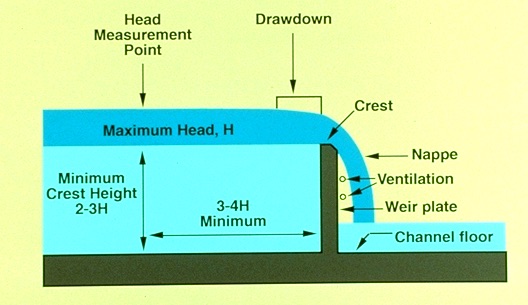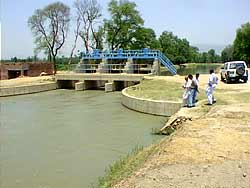Save Save Cross Regulator and Head Regulator Design For Later. A control transistor the 2N5551 a power transistor The TIP41 and a shunt resistor R.

Typical Design Layout For A Surface Drip Irrigation System Irrigation System Design Drip Irrigation System Design Irrigation
To help water escape from canals in conjunction with escapes.

. Application of the material of Chapters 7 and 8 to design closed-loop regulators that employ switching converters. The crest of a cross regulator is generally kept at the upstream bed level of the channel. Video includes the DESIGN OF CROSS REGULATORSTEP1.
While the crest level of the distributary head regulator is generally kept 03 to 10 m higher than the crest level of the cross regulator. Regulation of the canal system. Head Regulator A suitably designed regulator at the head of a canal is provided to regulate the supplies entering the canal as well as to control silt entry into the canal.
It is similar in construction to the head regulator. Design a cross regulator and a head regulator for a channel which takes off from parent channel. Up to 24 cash back 135.
Procedure of design a cross and head regulator 1- Crest level and length Cross regulator US bed level. The gates can be operate from the road. Cross Regulator 43.
It is made up of three key components. Raising the water level in the main canal in order to feed the off take channels. How to design a feedback system that accurately regulates its output while rejecting disturbances.
Functions of Cross Regulators. Hence it is advantageous to use the head regulator as a metering structure too. Residential applications will generally require 11 inches water column amount of pressure required to push a column of water up 11 inches in a manometer or about 63 ounces per square inch and the regulator compensates for these pressure differences in the tank to supply a.
Silt reduces carriage capacity of flow. The gates can be operate from the road. Length of ds floorSTEP5.
Canal draws water from still pond. Design of Cross Regulator and Distributary Hêad Regulator Crest Levels. View Products Natural Gas Pressure Regulation.
Regulators are normally aligned at 90 to the weir. Water in excess of canal requirements is not allowed to escape under the sluice gates. Canal Head Regulator Structure at the head of canal taking off from a reservoir may consist of nu ber of spans separated by piers and operated by gates.
Head regulator 03 m to 1m. And head regulator respectively. The current regulator described in the circuit above is one of the simplest current regulator designs.
It is a hydraulic structure. Following are the common types of Canal Head Regulator. Silt is deposited in.
The structural design of the cross regulator has to be closely co-ordinated with that of the head regulator of offtake when built in conjunction with the same. INTRODUCTION Regulator works Cross regulator- main canal Head regulator- distributory COSS REGULATOR To rise water level in main canal Downstream side of distributary Along with road bridge. The sill of regulation is kept little higher than the us bed level of canal across which it is constructed.
It is a low-side current regulator. I Crest level of the cross regulator should generally be kept in level with the upstream bed level of the canal. Ds and us FSL of Distributary Silt factor Assume safe exit-gradient Glacis slope Design of Cross Regulator 1 Crest Level.
Vertical lift gates are fitted in the grooves. A cross regulator is a structure constructed across a canal to regulate the water level in the canal upstream of itself and the discharge passing downstream of it for one or more of the following purposes. Cross Regulator and Head Regulator Design.
To feed offtaking canals located upstream of the cross regulator. The canal head regulator should be properly aligned so as to minimize silt entry into the canal avoid backflow and avoid formation of stagnant zones in the pocket. Ex1 Design a suitable cross regulator at the main channel for the following data.
When a fall is available on the canal the cross regulator is constructed as a fall-regulator Fig. To achieve this the head regulator may be located at an angle of 90 to 110 with respect to the axis of the main weir. These are used for diversion of flow.
The cross- regulator may be flumed at the site. Design of Canal Regulators. Depth of cut-offsFor mo.
From Fisher and Tartarini direct and pilot operated regulators to TESCOM high pressure control regulators Emerson offers the industrys broadest portfolio of pressure control technologies enabling dependable solutions. Purpose of a Propane Regulator. Here we detail about the fourteen important design principles for head regulators.
Top Nonfiction on Scribd View More. Discharge of the parent canal140 cumecsvariable Discharge of distributary15 cumecsvariable Bed width of channel us52mvariable Bed width of parent channelds46mvariable Silt factor08mvariable Safe exit gradient15Assume Depth of. A cross-regulator is often combined with rail or a road bridge.
Upto 10 are considered preferable for smooth entry into canal. US DS Max discharge 150m3s Full supply level 200m 1998m. Cross regulator and distributary head regulator are provided to control the supplies passing down the parent channel and the offtaking channel respectively.
Design of Cross Regulator and Distributary Hêad Regulator Crest Levels. 03 This standard covers the criteria for hydraulic design and important. Read this article to learn about the twelve design principles for cross regulator and distributary head regulators.
92 12 92 found this document useful 12 votes 7K views 21 pages. 954 Design Example 1815. Propane tank pressure can range from under 10 psig to over 200 psig.
Ds floor level STEP4. Velocity of water in the pocket is very much reduced. Design innovation and durability even in the worlds most rugged environments.
A cross regulator is provided on the parent channel at the ds of the offtake to head up the parent channel at the channel to draw the required supply. For Cross Regulators abutments with grooves and piers are constructed parallel to the parent canal. The supplies passing down the parent canal and off take channel are controlled by cross regulator.
Head regulators are provided at the head of a canal off-taking from a river or a branch canal taking-off from a main. I connected after the load before the ground. 95 Regulator Design 1924.
Cross regulator is a structure constructed across a canal to regulate the water level in the canal upstream of itself and the discharge passing downstream of it for one or more of the following purposes. Some times from economic considerations the canal section is flumed at the regulator site to reduce width of the. I The crest level of the head regulator should be fixed higher than the crest of the under-sluices of the barrage with or without the silt excluder by 125 to 2 m to avoid silt entry into the canal.
Functions of Distributary Head Regulator. Ii The crest level and the waterway required by the head regulator are interrelated because the. Hydraulic Structures Head and Cross Regulators December 12 2010 In case of obligatory straight alignment of the parent channel the usual angle of the off take channel is 60º to 80º in most important works needs a model study.
It can also be used as a calibrated meter for assessment of the discharge entering the canal.

Cross Head Regulator Definition Purposes Uses Applications

Discover Regulator Wall Mounted Articulated Pot Filler Matte Black Wheel And Lever Handles Online Waterworks Pot Filler Industrial Pot Fillers Waterworks

Cross Head Regulator Definition Purposes Uses Applications




0 comments
Post a Comment